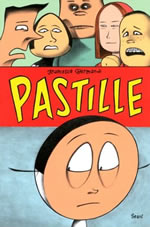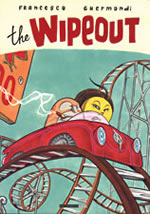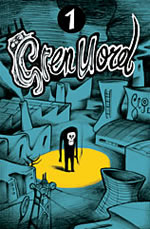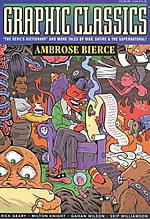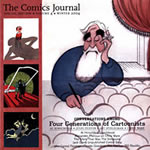Francesca Ghermandi:
Cartoon Noir
It is a moonlit evening in an enormous chateau deep in the Italian countryside. The long corridors are empty. Outside the winds moan. Alone in her cavernous bedroom, the night shadows gather around a little girl lying in her bed. Drowsy and a bit scared, she tries shutting her eyes to sleep. Vivid images start to dance before her eyes. She can’t stop visualising all the bedtime stories her mother and grandmother have been telling her, with their not-so-happy endings. The little girl’s nocturnal imaginings merge with the faces and creatures she has been absorbing in all day from her much loved comics and picture books, and the drawings she has made of her own. Sleep eventually comes, floating her on a tide of dreams to the morning.
Welcome to a night in the childhood of of Francesca Ghermandi, one of Italy’s most talented and exuberant comics creators. Growing up in a huge house with her sculptor father and artist mother, it must have seemed as if she had a castle for her home and magicians for her parents. From the earliest age, making art and stories became part of her everyday life and as a student making comics or ‘fumetti’ would be her chosen postgraduate studies. It was at Bologna’s Zio Feininger comics school that she became inspired by American animation’s most manic genius Tex Avery.
If anything signaled an end to the sugary sweetness swamping American cartoons under Disney it was the short, sharp sniff of Screwy Squirrel in Screwball Squirrel in April 1944. With this short, Screwy escorts the supposed star of the cartoon - a charming, chattering squirrel - behind a tree, where he proceeds to beat him up and then hijack the cartoon to his own ends. Avery’s sadistic, selfish squirrel personifies the sheer entertaining anarchy of seeing established order and common sense demolished. "In a cartoon everything is possible," and the same is true in Francesca’s funny animal fumetti.
Helter Skelter is her cat sheriff of the future, named after the book and movie about the Charles Manson murders. His one weakness is a ravenous appetite for sardines. In the delirious ‘splatter cartoon’, her moral guardian is always being persecuted either by a grinning horned devil midget or by his own criminal brother, Killer Driller, but according to the laws of cartoon physics, always bounces back unscathed for more punishment.
Francesca’s first publication in English, in David Mazzucchelli’s Rubber Blanket in 1993, led to her next series being picked up by Kim Thompson at Fantagraphics from 1997 for the anthology Zero Zero in issues 19, 20, 22 and 24.
In Pop. 666 (as in population 666, the cursed number), Francesca and writer Massimo Semerano invented the improvised ghetto of San Lazzaro, described by Thompson as like, "Palomar on acid." No funny animals live here, but the human inhabitants are equally grotesque, obsessive and destructive.
Even at the bottom of society, there is always someone else even lower to exploit. Extortionist and sex-starved glutton Rocco terrorises the villagers by forcing them to pay taxes on ‘his’ land, but beneath his brutal exterior, he pines for his forgotten movie starlet Hilde Historieta, now a desiccated, aquaphobic shell. When Francesca was only eight, she was transfixed by Chester Gould’s stark black and white morals in Dick Tracy, one of her inspirations here. The difference is that there is no square-jawed detective dispensing justice, only a godless slum, where everyone pays for their sins , including the innocent. This is true ‘cartoon noir’, so desperate and absurd that it becomes chillingly funny.
The tone is her three wordless Pastille albums (Seuil) appears much lighter, recalling Lewis Carroll’s Alice In Wonderland, although the world can still be threatening for this hapless heroine with a head shaped like a Tylenol tablet. Silent comics take you back to an age before you could read words, when you could only try to make sense from what you see. They force you to read the faces and body language, to spot the clues from one panel to the next, to really look. The effect of this is to make you feel the same sort of disorientation that Pastille is going through, heightened by the textures and atmosphere in Francesca’s pencilling and shading. There is a little of Francesca in all her characters, but I think this little girl with a hyperactive imagination particularly taps into her memories and feelings from childhood.
Cartoon noir also best describes her latest 80-page large-format colour album The Wipeout, also from Fantagraphics. Francesca’s cast of misfits may look like cute advertising mascots and cartoon figurines, but their passions are all too sordidly human.
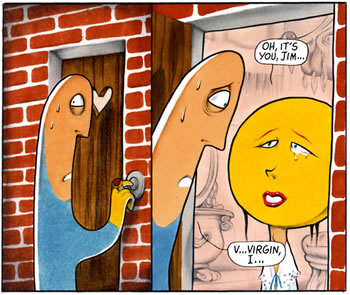
Meet hen-pecked husband Jim Tartaglia, a big-nosed, overly flexible, die-cut silhouette. He’s a poorly paid, absent-minded chemist, who easily lapses into erotic nightmares, when he’s not busy refining his revolutionary all-purposes cleaner. No wonder, when all his bald beachball wife Bawl yearns for are the latest hair transplants, way beyond their means. Their stagnating marriage reaches breaking point when Jimbo falls in love with dishy brunette Virgin Prunes upstairs. When they accidentally discover that Jim’s cleaner mixed with milk literally wipes people out, erasing every identifiable trace, Virgin lures Jim into using it to murder a blackmailing loan shark.
But in true Femme fatale tradition, her motives are far more devious. Since Jim is the same shape as her husband, Virgin and Bawl plot together to wipe Jim out and pass his blank corpse off as that of Mr Prunes so they can split his life insurance. In this dizzying maelstrom of desire and deceit, part Double Indemnity, part Mulholland Drive, you need your wits about you to distinguish dream from reality, present from past or future, truth from lies.
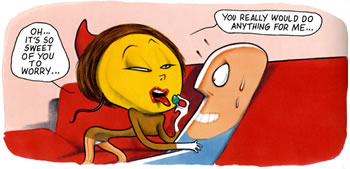
Francesca’s hardboiled fantasia dazzles in its lustrous palette, harking back to vintage Disney cels and Sixties Italian advertising illustration. Like the rollercoaster on the cover, its spiralling logic rattles around the tracks of your mind, long after you have woken up yourself.
In 2004, Francesca had a major gallery exhibition in the Museum Of Illustration in Ferrara, Italy and new strips appearing in the Graphic Classics collection of Ambrose Bierce adaptations and The Comics Journal’s 2004 Special. In her two-page strip she is auditioning a new character, an Addams Family-style skeletal figure who looks set to be the actor in another album now on her drawing board.
Francesca is back in her bedroom in the chateau. It’s getting dark, it’s time to go to sleep. Time to close your eyes and dream…
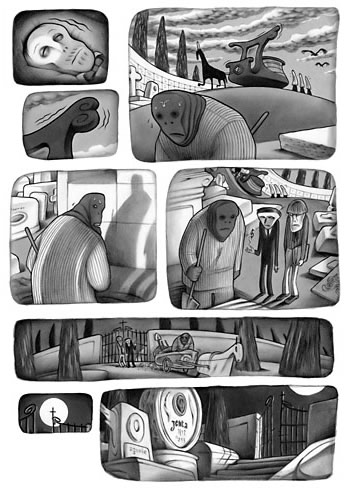
The original version of this article appeared in 2004 in Comics International, the UK’s leading magazine about comics, graphic novels and manga.













